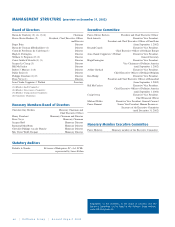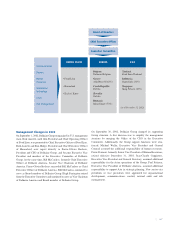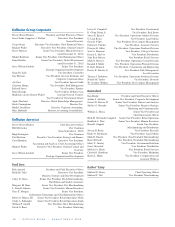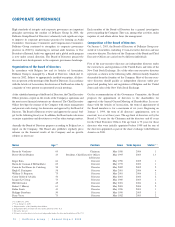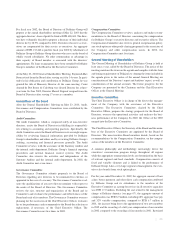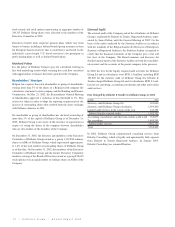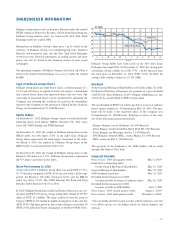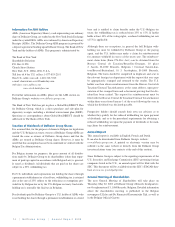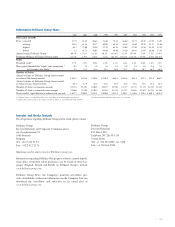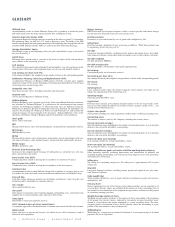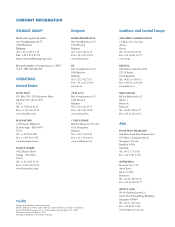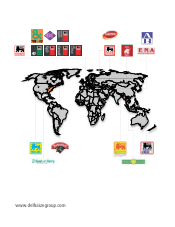Food Lion 2002 Annual Report Download - page 78
Download and view the complete annual report
Please find page 78 of the 2002 Food Lion annual report below. You can navigate through the pages in the report by either clicking on the pages listed below, or by using the keyword search tool below to find specific information within the annual report.
76 |Delhaize Group |Annual Report 2002
Affiliated store
An independent retailer to whom Delhaize Group sells its products at wholesale prices
and who benefits from the trade name and know-how of Delhaize Group.
American Depository Receipt (ADR)
An American Depositary Receipt represents ownership of the shares of a non-U.S. corporation.
The underlying shares are held by a U.S. bank as depositary agent. The holder of an ADR
benefits from dividend and voting rights pertaining to the underlying share through the bank that
issued the ADR. Delhaize Group’s ADRs are traded on the New York Stock Exchange.
Average Shareholders' Equity:
Shareholders' equity at the beginning of the year plus shareholders' equity at the end of
the year, divided by 2.
Capital leases
Financing leases which result in a transfer to the lessee of almost all the risk and advan-
tages inherent to the ownership of assets.
Cash earnings
Net earnings before amortization of goodwill and intangibles, store closing charges in the
normal course of business and exceptional items, net of taxes and minority interests.
Cash earnings per share (Cash EPS)
Cash earnings divided by the weighted average number of shares in the corresponding period.
Collaborative Planning, Forecasting and Replenishment (CPFR)
Acollaborative Business to Business (B2B) process whereby a retailer and a supplier
cooperate to improve the quality of planning, forecasting and replenishment with the goal
of lowering costs and increasing sales.
Comparable store sales
Sales from the same stores, including relocations and expansions.
Corporate store
Astore operated directly by Delhaize Group.
Delhaize Belgium
Delhaize Belgium is not a separate legal entity. In the consolidated financial statements,
any reference to “Delhaize Belgium” is a reference to the consolidation of the statutory
accounts of the Belgian companies, of which the major ones are Delhaize Group SA,
Delimmo SA, Delhaize The Lion Coordination Center SA, Delhome SA, Delanthuis SA,
Aniserco SA, Delshop SA, Wambacq & Peeters SA and Wintrucks SA, and excludes the
corporate expenses. In the remainder of the document, “Delhaize Belgium” refers to the
operations of Delhaize Group in Belgium and the Grand-Duchy of Luxembourg.
Direct goods
Goods sold to customers.
EBIT
Earnings before interest, taxes, other income/expense, exceptional items and minority interests.
EBIT margin
EBIT divided by sales.
EBITDA
Earnings before interest, taxes, depreciation, amortization, store closing charges in the nor-
mal course of business, other income/expense, exceptional items and minority interests.
EBITDA margin
EBITDA divided by sales.
Electronic Data Interchange (EDI)
Systems for the computer-based exchange of information in a structured way with sup-
pliers, like invoices and orders.
Every Day Fair Price (EDFP)
Commercial policy aimed at offering the best products at consistent low prices.
Every Day Low Price (EDLP)
Commercial policy aimed at offering the best products at the lowest prices.
Franchised store
An independent retailer to whom Delhaize Group sells its products at a net price (plus a year-
ly franchise fee) and who benefits from the trade name and know-how of Delhaize Group.
Free cash flow
Cash flow before financing activities less dividends and directors’ share of profit, less
dividends paid by subsidiaries to minority interests.
Gross margin
Gross profit divided by sales.
Gross profit
Sales minus cost of goods sold (excluding shipping and handling costs, and income from
suppliers for in-store promotions and cooperative advertising).
Group equity
Shareholder’s equity plus minority interests.
HACCP (Hazard Analysis of Critical Control Points)
Asystematic approach to the identification, evaluation and control of food safety hazards.
Indirect goods
Goods necessary to operate the business, but which are not sold to customers, such as
office and store equipment.
Interest coverage
EBITDA divided by net interest expenses, which is interest payable and similar charges
less income from financial fixed assets and current assets.
Inventory turnover
Inventories at year-end divided by cost of goods sold, multiplied by 365.
Natural food
Food that has had a minimum (if any) processing or additives. While these products can
be organically grown, they may not be.
Net debt
Long-term financial liabilities, including current portion and capital leases, plus short-
term financial liabilities, minus short-term investments (excl. treasury shares) and cash.
Net debt-to-EBITDA
Net debt divided by EBITDA
Net debt-to-equity ratio
Net debt divided by Group equity (after profit appropriation).
Net earnings
Consolidated profit, net of minority interests.
Net earnings per share (EPS)
Net earnings divided by the weighted average number of shares in the corresponding period.
Net income
Net earnings
Operating leases
Lease contracts under which the Group recognizes rental expense and which do not
require the capitalization of the underlying asset.
Operating margin
Operating profit divided by sales.
Organic food
Food that meets specific, governmental standards relative to the use of pesticides, fertil-
izers or any other chemicals and the way natural resources (animals, energy, water,…) are
treated in the production process.
Organic sales growth
Sales growth excluding sales from acquisitions and divestitures at identical exchange rates.
Outstanding shares
The number of shares issued by the Company, including the treasury shares.
Pay-out-ratio (cash earnings)
Gross dividend per share multiplied by the number of outstanding shares at year-end, plus
directors’ share of profit, divided by cash earnings.
Pay-out-ratio (net earnings)
Gross dividend per share multiplied by the number of outstanding shares at year-end, plus
directors’ share of profit, divided by net earnings.
Return on equity (cash earnings)
Cash earnings divided by average shareholders’ equity.
Return on equity (net earnings)
Net earnings divided by average shareholders’ equity.
Salaries, Miscellaneous goods and services and Other operating income/expense
Other operating expenses excluding depreciation and amortization of goodwill and
including shipping and handling costs and income from suppliers for in-store promotions
and cooperative advertising.
Selling area
Net selling area, excluding storage area. Net selling area = approximately 84% of gross
selling area.
Total debt
Long-term financial liabilities, including current portion and capital leases, plus short-
term financial liabilities.
Trade payable days
Trade payables divided by (cost of goods sold plus miscellaneous goods and services),
multiplied by 365.
Treasury shares
Shares repurchased by one of the Group’s legal entities and that are not cancelled as of
year-end date. Treasury shares are included in the number of shares outstanding but are
not included in the calculation of the weighted average number of shares for the purpose
of calculating earnings per share.
Weighted average number of shares
Weighted average number of shares is the number of shares outstanding at the beginning
of the period (less treasury shares), adjusted by the number of shares cancelled, repur-
chased or issued during the period multiplied by a time-weighting factor. The time-
weighting factor is the number of days that the specific shares are outstanding as a pro-
portion of the total number of days in the period.
Withholding tax
Withholding by a corporation or financial institution of a certain percentage of dividend
payments due to tax legislation.
GLOSSARY


